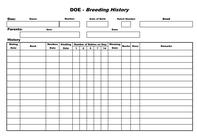
Overview
With any business record keeping is what makes the success or failure of the enterprise. It is necessary to keep record of all costs and the income of the business – and do understand that any agricultural operation is a business. Sometimes it is a very small business but sometimes it can become a very big one with proper record keeping. Even for a rabbit business that has only four or five does (female rabbit), a basic system of record keeping is essential.
All money spent on the business needs to be noted. This includes the cost of the rabbits, the cages, management equipment and feed.
Money coming in from the sale of stock or product needs to be noted.
Any action involving the breeding program needs to be noted. Nothing is worse than forgetting to give a doe a nest box and going to your rabbits in the morning and finding dead, ice cold babies on the floor.
Keeping track of weaning dates is essential.

Hutch Cards
Every cage should be numbered and a hutch card can be placed on each cage. It must be positioned in such a way that the rabbit cannot chew it to pieces and protected from getting wet or soiled. It can also be stored in a file and referred to daily.
On the hutch card write down everything that happens to the rabbit such as mating date, birthday and number of babies born. Have several columns for keeping a note of how many babies are still in the nest on day 2, 6, 14 up until weaning. Also have a column for foster babies added to the nest.
The name or number of the buck (male rabbit) used must also be on the card. (See example of Hutch Card). Also keep a note in the file dates of any medical treatment given as well as dates of toe nail clipping, ear checks and so on.
It is good to keep a check on the weights of both breeding stock and growing youngsters. Keep this information in your file. Slaughter dates must be noted and the weights of both the rabbit before and after slaughter. This indicates expected income. Computer-based record keeping systems are available, but are only necessary in a large rabbit unit.
By Karoline Steenekamp